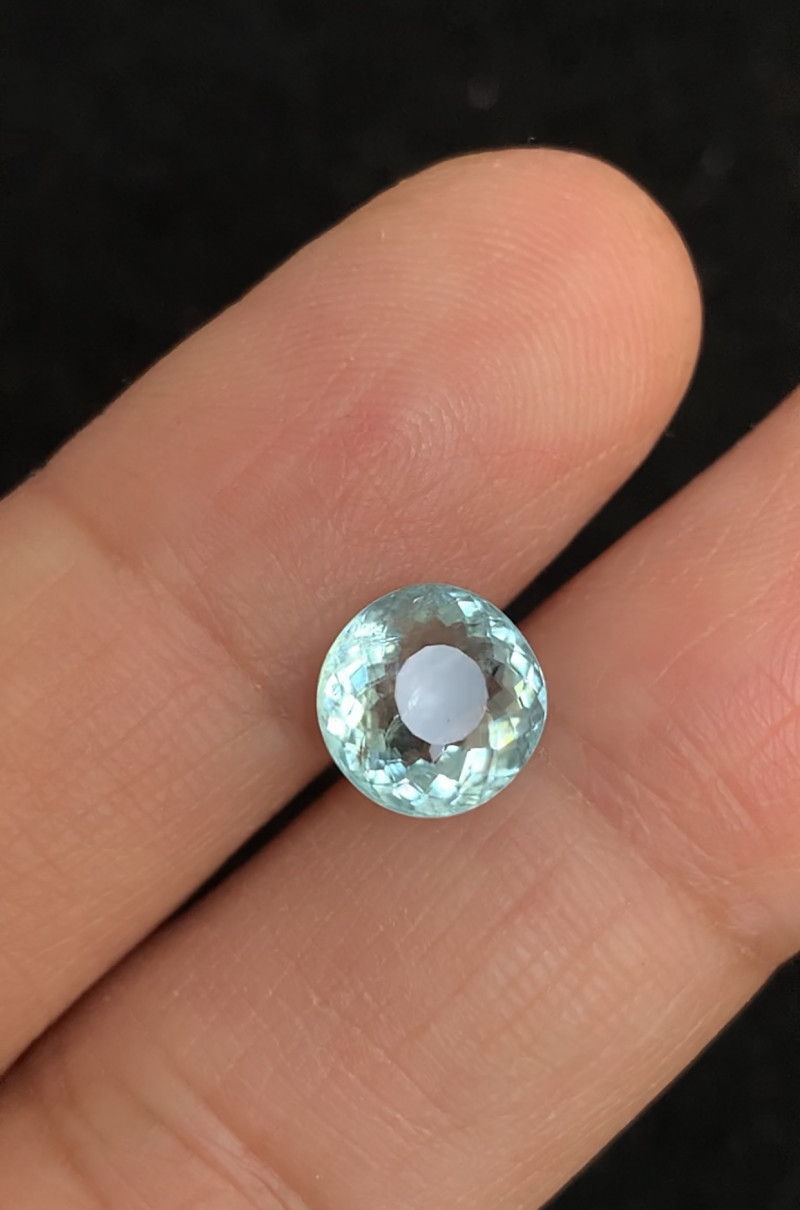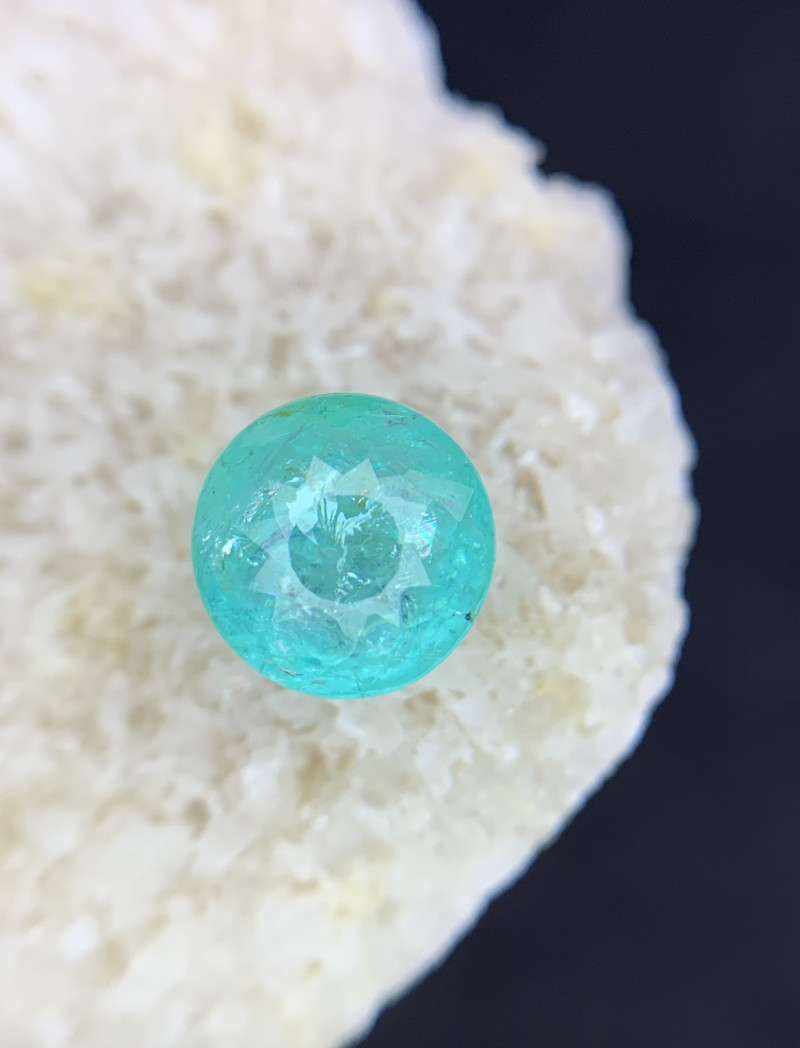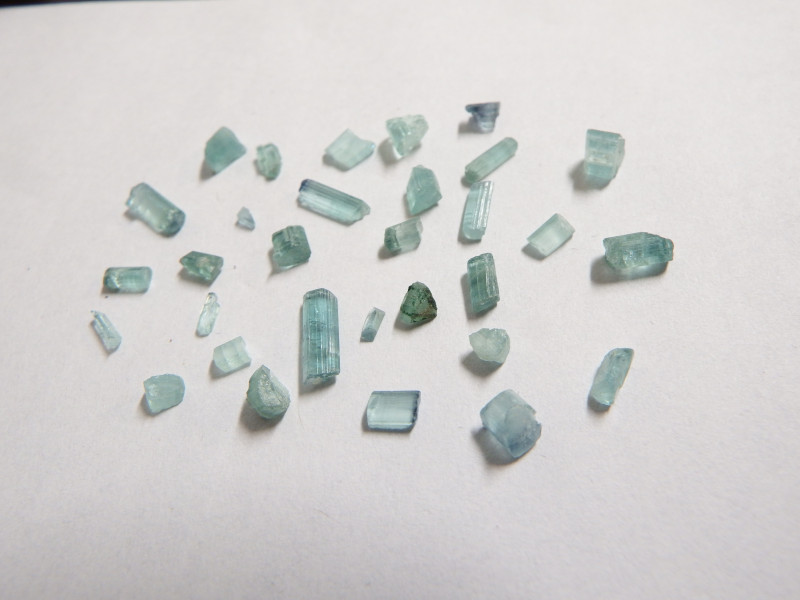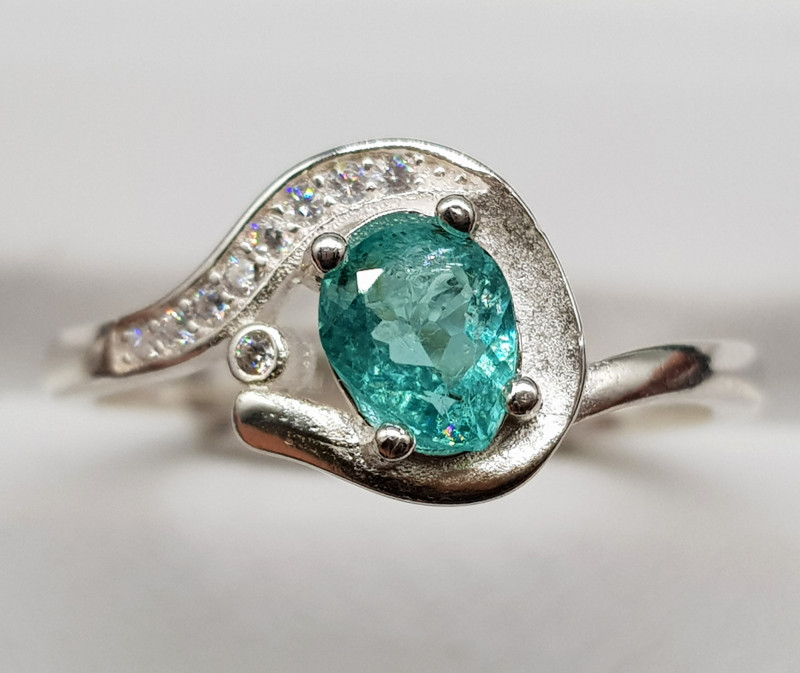
Paraíba-Turmalin: Preise, Eigenschaften, Bedeutung und Nutzen
 Der Paraiba-Turmalin ist ein blau-grüner Edelstein , der für seine leuchtenden Farben und seine Exklusivität geschätzt wird. Diese atemberaubende Turmalinvarietät wurde erst in den letzten Jahrzehnten entdeckt und hat seither internationale Anerkennung und einen Spitzenplatz unter den Edelsteinen erlangt.
Der Paraiba-Turmalin ist ein blau-grüner Edelstein , der für seine leuchtenden Farben und seine Exklusivität geschätzt wird. Diese atemberaubende Turmalinvarietät wurde erst in den letzten Jahrzehnten entdeckt und hat seither internationale Anerkennung und einen Spitzenplatz unter den Edelsteinen erlangt.
Ist Paraiba-Turmalin selten? Absolut. Blau ist nicht nur die seltenste Turmalinfarbe, sondern Paraiba-Turmalin zählt auch zu den seltensten Edelsteinen überhaupt – und dementsprechend hoch sind seine Preise.
Was macht Paraiba-Turmalin so einzigartig und wie viel ist er tatsächlich wert? Wir beantworten diese und weitere Fragen, während wir uns mit dem Wert, der Bedeutung, den Vorteilen und der Geschichte des Paraiba-Turmalins beschäftigen!

Über Paraíba-Turmalin
Paraiba-Turmalin ist ein Halbedelstein , obwohl er seltener ist als der Edelstein Diamant . Schätzungsweise wird nur ein Paraiba-Turmalin pro 10.000 geförderten Diamanten gefunden.
Ist Paraiba-Turmalin teurer als Diamant? Manchmal, aber es kommt auf den Diamanten an. Hochwertige weiße Diamanten mit einem Gewicht von 5 Karat oder mehr können bis zu 68.000 US-Dollar pro Karat kosten, während hochwertige Paraiba-Turmaline in der gleichen Gewichtsklasse bis zu 87.000 US-Dollar pro Karat erzielen können.
Als Turmalin ist dieser Edelstein der Geburtsstein für Oktober , der Sternzeichenstein Waage und ein Schmuckstein zum 8. Hochzeitstag . Obwohl Paraiba-Turmalin im Allgemeinen teurer ist, kann er auch als Geburtsstein für März anstelle von Aquamarin verwendet werden.
Spezifikationen und Eigenschaften des Paraíba-Turmalins
Die Turmalin-Familie ist komplex und umfasst zahlreiche Gruppen und Varietäten. Die meisten Gemmologen sind sich einig, dass der Paraiba-Turmalin zur Elbait-Art gehört, zusammen mit Indicolith , Rubellit und Wassermelonen-Turmalin, um nur einige zu nennen.
Elbaite-Turmalin-Varietäten sind Natrium-, Lithium- und Aluminiumborosilikate. Paraiba-Turmalin zeichnet sich durch seinen Kupfergehalt aus, was ihm die Bezeichnung „kupferhaltiger Elbaite“ eingebracht hat.
Einige wenige Paraiba-Turmaline gehören streng genommen zur Liddicoatit-Turmalinserie und nicht zur Elbait-Serie, obwohl diese selten sind. Liddicoatit ist eine seltene Turmalinserie, die der Elbait-Serie sehr ähnlich ist, jedoch Kalzium anstelle von Natrium enthält.

Wie man Paraiba-Turmalin erkennt
Die beste Methode , Paraiba-Turmaline von anderen Turmalinen zu unterscheiden, besteht darin, ihr Absorptionsspektrum mit einem Spektroskop zu betrachten.
Während die meisten Turmaline keine diagnostischen Absorptionsspektren aufweisen, ist bei den kupferreichen Paraiba-Turmalinen eine allgemeine Absorption in einem breiten Bereich ab 600 nm zu beobachten.
Mit einer Lupe kann man auch auf Facettenverdopplung prüfen, die ein Indiz für die hohe Doppelbrechung des Paraiba-Turmalins ist.
Beim Vergleich von Paraiba-Turmalin mit anderen Edelsteinen wie Topas oder Beryll kann man die Härte betrachten. Paraiba-Turmalin hat auf der Mohs-Skala eine Härte von 7 bis 7,5, während Topas und Beryll bei 8 liegen.
Nachfolgend sind die mineralischen Eigenschaften des Paraiba-Turmalins aufgeführt:
Mohshärte : 7-7,5
Farbe : Blau-, Grün- und Blaugrüntöne; selten Violett, Lila oder Rosa.
Kristallstruktur : Hexagonal (trigonal)
Glanz : Glasartig bis harzig
Transparenz : Von durchscheinend bis transparent
Brechungsindex : 1,603–1,655
Dichte : 2,84–3,10
Dekolleté : Keines
Fraktur : Muschelförmig oder uneben
Streifen : Weiß
Lumineszenz : Fluoreszenz ist gelegentlich vorhanden, aber schwach.
Pleochroismus : Häufig vorhanden in Blaugrün/Blau und Hellgrün bis Rosa bis Violett/Farblos
Doppelbrechung : 0,013–0,024
Streuung : 0,017
Optische Effekte : Selten Chatoyance, Asterismus, Farbwechsel
Nachdem wir die Mineralogie behandelt haben, wenden wir uns nun der metaphysischen Seite des Steins zu.

Bedeutung und Geschichte des Paraíba-Turmalins
Die Farbe des Paraiba-Turmalins erinnert an die beruhigenden Blau- und Grüntöne des Meeres, insbesondere des Karibischen Meeres vor der Küste Brasiliens. Metaphysisch symbolisiert der Kristall Intuition, Kreativität und Intellekt.
Geschichte
Der brasilianische Bergmann Heitor Dimas Barbosa, der als „Vater des Paraiba-Turmalins“ gilt, entdeckte den Stein 1989 in Paraiba nach jahrelangem Abbau von Pegmatiten. Kurz darauf folgte eine weitere Entdeckung in Rio Grande do Norte, Brasilien.
Nachdem Forscher herausgefunden hatten, dass die Steine einen einzigartigen Kupfergehalt aufwiesen, stieg ihre Popularität rasant an.
Im Jahr 2000 wurden in Nigeria kupferhaltige Turmaline entdeckt. Der afrikanische Edelsteinhändler Moussa Konate entdeckte um das Jahr 2001 weitere afrikanische Paraiba- Turmaline in einer Partie mosambikanischer Turmaline.
Was genau macht einen Turmalin zu einem Paraiba-Turmalin? Obwohl der Name vom ursprünglichen Fundort des Edelsteins abgeleitet ist, bleibt die wahre Antwort unter Gemmologen Gegenstand einiger Debatten.
Manche Gemmologen bezeichnen ausschließlich brasilianisches Material als Paraiba und kennzeichnen afrikanische Exemplare als „Paraiba-ähnlich“ oder „kupferhaltig“. Berichte von renommierten Edelsteinlaboren definieren Paraiba-Steine jedoch anhand ihres Kupfergehalts und nicht anhand ihrer Herkunft.
Der Weltverband der Schmuckindustrie (CIBJO) bestätigte „Paraiba“ bereits 1999, also vor den afrikanischen Funden, als offiziellen Handelsnamen.
Nach den Entdeckungen beschloss die Internationale Konferenz der Edelsteinlaboratorien im Jahr 2006, dass die Bezeichnung „Paraiba-Turmalin“ für alle Steine unabhängig von ihrer Herkunft gelten soll. Das Internationale Komitee zur Harmonisierung von Laborhandbüchern (LMHC) bestätigte diese Entscheidung kurz darauf.

Heilende Eigenschaften des Paraíba-Turmalins
Paraiba-Turmaline sind wirksame Heilsteine . Grüner Paraiba-Turmalin bringt, wie andere grüne Edelsteine , Hoffnung, Freude und Glück. Blaue Exemplare fördern, wie andere blaue Edelsteine, geistige Klarheit und innere Ruhe.
Darüber hinaus sind Paraiba-Turmaline hervorragende Steine für das Halschakra, die es Ihnen ermöglichen, Ihre Wahrheit zu verstehen und auszudrücken.
Körperliche Heilung
Zu den angeblichen Vorteilen des Paraiba-Turmalins gehört die Unterstützung bei folgenden Beschwerden:
Arthritis
Heuschnupfen
Schilddrüsenprobleme
Augenprobleme
Halsschmerzen
Emotionale Heilung
Auf emotionaler Ebene soll Paraiba-Turmalin Intellekt und Intuition fördern. Er soll Selbstzweifel und Negativität vertreiben und die Heilung nach Trennungen unterstützen.

Eigenschaften von Paraíba-Turmalin-Edelsteinen
Der Wert eines Paraiba-Turmalins hängt von seiner Farbe, Reinheit, seinem Schliff, seinem Karatgewicht, seiner Herkunft und seiner Behandlung ab. Farbe, Funkeln und Schliff sind dabei die wichtigsten Faktoren.
Farbe
Anders als das Eisen, das für die blauen bis blaugrünen Farbtöne im Indigolith verantwortlich ist, ist Kupfer für die leuchtenden Blau- und Grüntöne des Paraiba-Turmalins verantwortlich, was zu satteren Farben führt. Eisen oder Mangan erzeugen grüne Untertöne. Mangan verbindet sich mit Kupfer und erzeugt seltene violette, purpurne oder rosafarbene Farbtöne.
Neonblauer Paraiba-Turmalin ist die wertvollste Farbe, während überwiegend grüne Steine weniger wertvoll sind. Paraiba-Turmale weisen typischerweise einen mittleren Farbton und eine hohe Farbsättigung auf.
Obwohl rosa und violette Paraibas selten sind, sind sie nicht so wertvoll wie grüne oder blaue.
Einige seltene und wertvolle Paraiba-Turmaline sind farbwechselnd und wechseln von Violett im Fluoreszenzlicht zu Blaugrün oder Grau im Glühlampenlicht.
Klarheit
Paraiba-Turmalin hat die Reinheitsstufe III für farbige Edelsteine und weist daher üblicherweise sichtbare Einschlüsse auf. Obwohl Einschlüsse den Wert nicht wesentlich mindern, sind Paraiba-Turmaline ohne Einschlüsse selten und von besonders hohem Wert.
Ein möglicher Einschluss ist Kupfer, das im gesamten Edelstein für Funkeln sorgen und das Innere hervorheben kann.
Selten können Paraiba-Edelsteine hohle Röhren aufweisen, die vierstrahlige Lichtreflexe („Sterne“) auf ihrer Oberfläche erzeugen (ein optischer Effekt namens Asterismus). Häufiger führen diese Einschlüsse jedoch dazu, dass die Steine eine einzelne Lichtlinie reflektieren (auch Chatoyance oder „Katzenaugeneffekt“ genannt).
Schneiden
Da das Material knapp ist und Turmaline relativ leicht zu schleifen sind, werden fast alle Paraiba-Turmaline in individuellen, oft ovalen Formen facettiert . Schliffe, die das Funkeln und die Farbe des Steins optimal zur Geltung bringen, sind besonders wertvoll.
Schliffe mit geringerem Wert sind asymmetrisch und nicht proportional, was oft zu Fenstereffekten und einem Mangel an Funkeln führt. Seltene Exemplare mit Chatoyance oder Asterismus müssen als Cabochons geschliffen werden, um den Effekt optimal zur Geltung zu bringen. Zu viele Einschlüsse können außerdem dazu führen, dass ein Paraiba-Turmalin-Cabochon einen facettierten Edelstein überstrahlt.
Karatgewicht & Größe
Brasilianische Paraiba-Turmaline wiegen üblicherweise 1–2 Karat oder weniger. Afrikanische Paraiba-Turmaline können bis zu 20 Karat erreichen.
Der Preis pro Karat für Paraiba-Turmalin variiert typischerweise zwischen einem, zwei, drei, zehn und zwanzig Karat, abhängig von der Herkunft.
Quelle
Die Herkunft eines Paraiba-Turmalins kann seine Qualität und seinen Preis beeinflussen. Brasilianische Exemplare sind in der Regel am teuersten und weisen typischerweise eine großartige Farbe, aber eine geringe Reinheit und kleine Größen auf.
Mosambik ist bekannt für seine größeren Paraiba-Turmaline mit ähnlich intensiver Farbe und besserer Reinheit. Nigerianische Exemplare weisen typischerweise eine geringere Farbsättigung auf und sind günstiger.
Insgesamt ist es unglaublich schwierig festzustellen, ob ein Paraiba-Turmalin aus der einen oder anderen Quelle stammt – dazu ist eine professionelle chemische Analyse erforderlich.
Behandlungen & Simulantien
Einige Paraiba-Turmaline werden erhitzt und/oder bestrahlt, um ihre Farbe zu verändern. Durch Hitze werden entweder zu dunkle Farben aufgehellt oder violette Farben blau gefärbt.
Gelegentlich werden Laserbohrungen oder Rissfüllungen durchgeführt, um die Transparenz zu verbessern. Diese Behandlungen können den Wert mindern.
Imitationen sind häufiger als synthetischer Paraiba-Turmalin. Gängige Imitationen sind andere Turmaline, Glas, Zirkonia , Apatit und synthetischer Beryll .

Entstehung und Quellen des Paraíba-Turmalins
Die meisten rohen Paraiba-Turmaline entstehen in Pegmatitgesteinen, einige tauchen jedoch in alluvialen Ablagerungen auf, die durch die Verwitterung dieser Gesteine entstehen.
Die Entstehung des Steins ist einzigartig, da er sich in der Nähe von beträchtlichen Mengen an Kupfer und/oder Mangan bildet. Kupfer kommt in keinem anderen Turmalin vor.
Abbaugebiete
Derzeit stammen Paraiba-Turmaline ausschließlich aus Brasilien, Mosambik und Nigeria. Die hohe Nachfrage nach Paraiba-Turmalin aus Brasilien hat zu deren nahezu vollständiger Erschöpfung in der Region geführt.
Welche Preise sind zu erwarten?

Preis und Wert des Paraíba-Turmalins
Paraiba-Turmaline sind kostspielige Steine, wobei Cabochons und weniger gefragte Farben erschwinglicher sein können. Warum ist Paraiba-Turmalin so teuer? Das liegt an seiner Seltenheit und der hohen Nachfrage.
Zunächst zu den Preisen für brasilianische Paraiba-Turmaline:
0,20–0,99 Karat : 150 bis 15.500 US-Dollar pro Karat
1,00–1,99 Karat : 550 bis 30.000 US-Dollar pro Karat
2,00–2,99 Karat : 950 bis 40.000 US-Dollar pro Karat
3,00–4,99 Karat : 1.100 bis 55.000 US-Dollar pro Karat
5+ Karat : 3.000 bis 55.000 US-Dollar pro Karat
Als Nächstes die Preisspannen pro Karat für Paraiba-Turmalin aus Nigeria und Mosambik:
0,20–2,99 Karat : 70 bis 5.500 US-Dollar pro Karat
3,00–4,99 Karat : 70 bis 14.000 US-Dollar pro Karat
5,00–9,99 Karat : 70 bis 16.000 US-Dollar pro Karat
10+ Karat : 700 bis 20.000 US-Dollar pro Karat
Zum Schluss gehen wir auf die richtige Pflege von Edelsteinen ein.
Pflege und Wartung des Paraíba-Turmalins
Turmaline sind extrem widerstandsfähig und eignen sich hervorragend für den Alltag. Für einen Paraiba-Turmalin-Ring empfiehlt sich möglicherweise eine schützende Fassung .
Reinigen Sie den Stein mit einer weichen Zahnbürste, die Sie in eine Mischung aus warmem Wasser und milder Seife getaucht haben. Verwenden Sie keine mechanischen Reinigungsmittel (z. B. Ultraschall- oder Dampfreiniger), da diese Flüssigkeitseinschlüsse ausdehnen und zum Bruch des Steins führen können.

Strahlend wie das Meer mit Paraiba-Turmalin!
Bevor die Paraiba-Turmaline entdeckt wurden, galten Turmaline lediglich als Imitationen „besserer“ Edelsteine. Diese Vielfalt hat dazu beigetragen, dass Turmaline für ihr prächtiges Farbspektrum und ihre positiven Eigenschaften die ihnen gebührende Anerkennung erlangt haben.
Tatsächlich zählen viele Paraiba-Turmaline neben den „großen Drei“ (Rubin, Saphir und Smaragd) zu den begehrtesten Edelsteinen für Sammler.
Ob Sie den Edelstein in einer Sammlung ausstellen, ihn als Geburtsstein tragen oder einfach nur mit funkelnden Paraiba-Turmalin-Ohrringen alle Blicke auf sich ziehen, dieser Edelstein wird Ihrem Leben mit Sicherheit etwas Glanz verleihen.
Suche nach Gemstone Encyclopedia
Verwandte Auktionen
In Verbindung stehende Artikel
Russland ist ein riesiges Land mit unermesslichen Mineral- und Edelsteinreserven. Russland hat sich zu einem bedeutenden Diamantenproduzenten und -produzenten entwickelt.
9th May 2018
Werfen wir einen Blick auf die 10 größten Diamanten, die je gefunden wurden. Sie werden nie erraten, wie groß der Diamant ist, der den ersten Platz belegt.
9th May 2018
Asien ist eine Region der Erde, die einige der außergewöhnlichsten Edelsteine hervorbringt. Rubin, Saphir und Spinell stammen alle aus dieser Region.
9th May 2018
Neue Artikel
Schnitzereien aus Palmenelfenbein, auch pflanzliches Elfenbein genannt, sind eine natürliche Alternative zu Elefantenelfenbein und werden ethisch vertretbar aus den Nüssen der südamerikanischen Phytelephas-Palme gewonnen. Erfahren Sie in diesem Ratgeber alles Wissenswerte über Palmenelfenbein!
15th Jan 2026
Chrysanthemenblütensteine sind Naturwunder mit einem weißen Kalzit-, Celestin- oder Andalusit-Blumenmuster, das sich vom schwarzen Kalkstein oder Tonstein abhebt.
13th Jan 2026
Der Regenbogen-Gitter-Sonnenstein ist eine Feldspatvarietät mit drei wunderschönen optischen Effekten, die durch verschiedene Einschlüsse hervorgerufen werden. Sein feuriges Farbenspiel und das Gittermuster machen ihn zu einem seltenen Sammlerstück!
12th Jan 2026
Artikelkategorien
How To's is where you will find helpful articles from gem Rock Auctions on how to cut gemstones, select gemstones and buy gemstones.
9 Artikel







